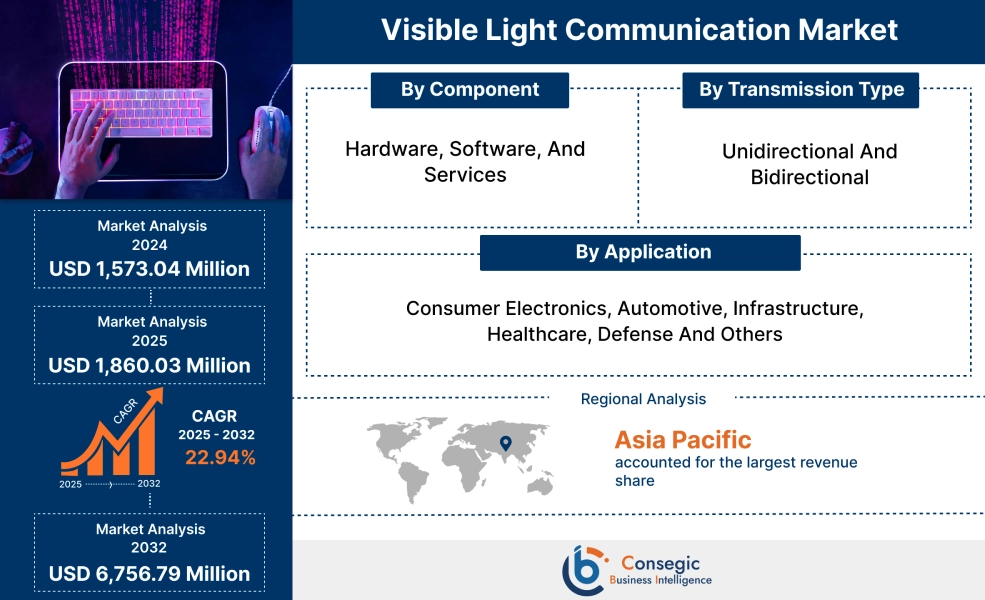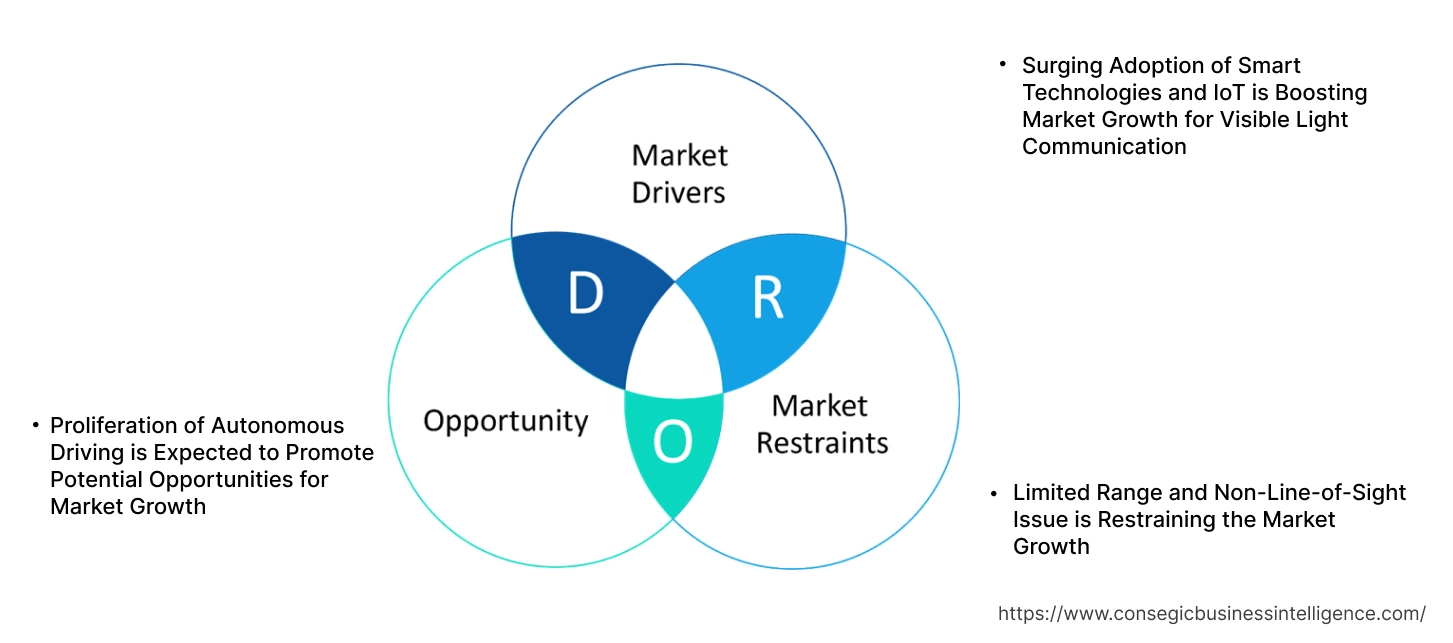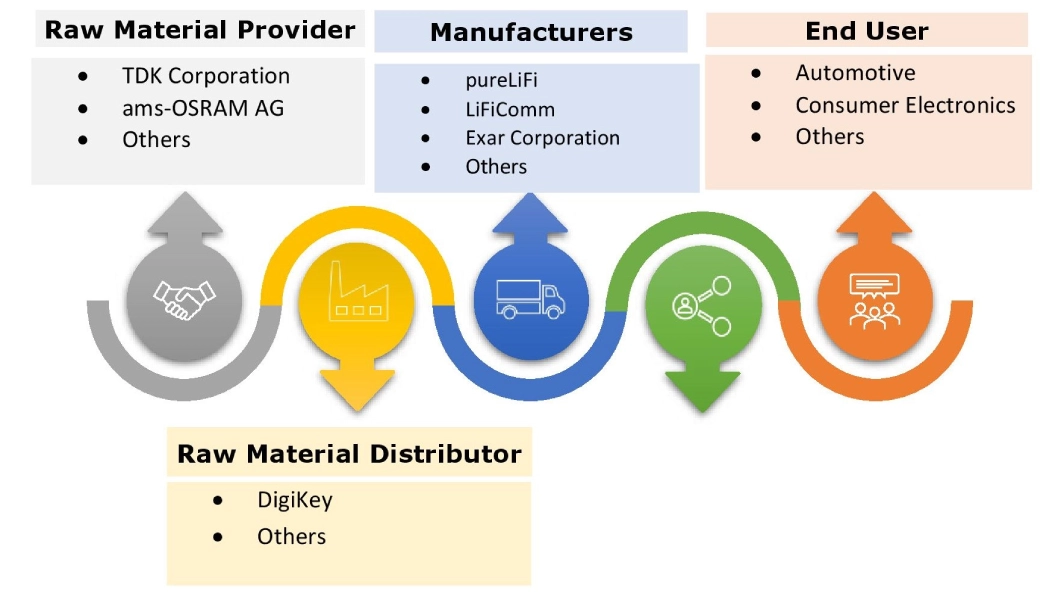Visible Light Communication Market Size:
Visible Light Communication Market size is estimated to reach over USD 6,756.79 Million by 2032 from a value of USD 1,573.04 Million in 2024 and is projected to grow by USD 1,860.03 Million in 2025, growing at a CAGR of 22.94% from 2025 to 2032
Visible Light Communication Market Scope & Overview:
The visible light communication (VLC) is a wireless communication technology which utilizes visible light signals to transmit data. The key characteristics of VLC include high data transfer rates, low latency, higher security, no interference, and congestion free among others. Moreover, the key advantages include enhanced security, reduced interference, and potential cost savings are driving the visible light communication market growth. Further, the rising need for high data transmission rates with minimal power consumption is boosting the visible light communication market demand.
Visible Light Communication Market Dynamics - (DRO):
Key Drivers:
Surging Adoption of Smart Technologies and IoT is Boosting Market Growth for Visible Light Communication
The surging demand for high-bandwidth communication solutions such as IoT and smart technologies within homes, buildings, and vehicles is driving the visible light communication market demand. Further, visible light communication plays a key role in enabling high-speed, energy-efficient, and interference-free wireless communication using the visible light spectrum for connected IoT devices.
- For instance, According to IoT Analytics, number of connected IoT devices penetration reached 16.6 billion globally in the year 2023. The rising adoption of connected IoT devices is paving the way for the proliferation of the visible light communication industry.
Therefore, the surging demand for high-bandwidth communication solutions is driving the need for visible light communication market growth.
Key Restraints:
Limited Range and Non-Line-of-Sight Issue is Restraining the Market Growth
The systems usually have a shorter communication range and are vulnerable to barriers which in turn hinders the visible light communication market expansion. Additionally, when the transmitter and receiver are not in direct line of sight restricts the effectiveness of the system. Further, the limited range of VLC also poses challenges for applications in large-scale ITS deployments.
Therefore, the limited range and non-line-of-sight issue is hindering the visible light communication market expansion.
Future Opportunities :
Proliferation of Autonomous Driving is Expected to Promote Potential Opportunities for Market Growth
The vehicles with features such as parking assistance, car tracking, and automated navigation utilize visible light communication for improved situational awareness in connected vehicle systems. Additionally, the system helps to enhance the coordination and communication among vehicles in turn paving the way for visible light communication market opportunities. Further, the rising demand for vehicle platooning systems for providing inter-vehicle communication is driving the market growth.
- For instance, according to Capgemini, 15% of cars sold in 2030 are forecasted to be fully autonomous and 95 million autonomous cars are expected to be sold annually by 2035.
Hence, the rising adoption of autonomous vehicles is anticipated to increase the utilization in turn promoting prospects for visible light communication market opportunities during the forecast period.
Visible Light Communication Market Segmental Analysis :
By Component:
Based on the component, the market is segmented into hardware, software, and services.
Trends in the Component:
- The increasing focus on advancement in modulation techniques of the system is driving the need for software components which in turn is fueling the visible light communication market.
- The trends towards increasing integration of hardware components with 5G/6G technology to reduce spectrum congestion and provide high-capacity backhaul solutions.
Hardware accounted for the largest revenue share of 66.24% in the year 2024 and is anticipated to register the fastest CAGR during the forecast period.
- The hardware components in the system include LEDs, photo detectors, microcontrollers, and others all working together to transmit data.
- Additionally, the key advantages of hardware components include high data transmission rates, enhanced security, and others.
- Further, the advancement in LEDs and photodetectors, for enabling high-speed optical communication is driving the visible light communication market share.
- For instance, VLNComm is a US-based technology firm focused on developing Visible Light Communication (VLC) systems. The company offers a lighting panel, USB Adapter, and DeskLamp embedded with LiFi to provide indoor wireless networking in offices, hospitals, libraries, schools, convention centers, airports, and warehouses.
- Thus, according to the visible light communication market analysis, advancement in LEDs and photodetectors is driving the adoption of the hardware segment which in turn is boosting the visible light communication market share.
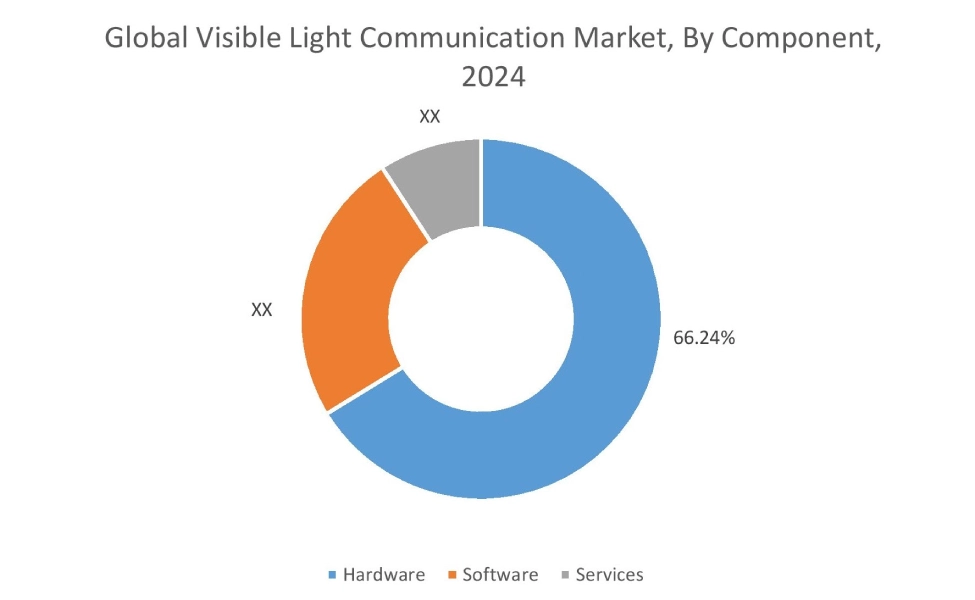
By Transmission Type:
Based on the transmission , the market is bifurcated into unidirectional and bidirectional.
Trends in the Transmission Type:
- The rising adoption of unidirectional transmission to provide secure and hazard-free data access in hospitals is boosting the visible light communication market trends.
- The trend toward the proliferation of smart cities initiatives is driving the adoption of bidirectional transmission which is essential for robust and efficient communication systems.
The unidirectional transmission accounted for the largest revenue share in the year 2024.
- The unidirectional transmission refers to the transmission of data in one direction typically from a transmitter to a receiver without a return path.
- Additionally, the key advantages of unidirectional transmission include high data rates, enhanced security, reduced interference, improved reliability, and cost-effectiveness which in turn boosts the visible light communication market size.
- Further, the rising need for automation in various industries such as factories, consumer electronics, and others is driving the adoption of unidirectional data transmission through VLC systems.
- Furthermore, the proliferation of IoT devices such as smartphones and sensors is increasingly being integrated with unidirectional VLC systems for high-speed data transmission.
- Thus, according to the visible light communication market analysis, the rising need for automation in various industries is driving the adoption of unidirectional transmission type which in turn is fueling the visible light communication market size.
The bidirectional transmission is anticipated to register the fastest CAGR during the forecast period.
- The bidirectional transmission refers to a system where data is transmitted and received simultaneously using visible light, such as from LEDs.
- Additionally, the key advantages of bidirectional transmission include enhanced security, reduced interference, and high data rates among others.
- Further, the rising adoption of bidirectional transmission in smart homes, vehicle-to-vehicle communication, and secure environments is boosting the visible light communication market trends.
- Therefore, as per the market analysis, the rising adoption of smart homes, vehicle-to-vehicle communication, and secure environments are anticipated to boost the market during the forecast period.
By Application:
Based on the application, the market is segmented into consumer electronics, automotive, infrastructure, healthcare, defense and others.
Trends in the Application:
- The trend towards the evolution of automotive software which provides the ability to update vehicle systems remotely with the help of LiFi technology is boosting the market progress.
- The trend towards growing focus on data security and real-time patient monitoring as well as integration with IoMT devices is boosting the market progress.
Consumer Electronics accounted for the largest revenue share in the year 2024.
- The consumer electronics sector is increasingly focusing on integrating systems with device-to-device communication as well as complementing existing Wi-Fi networks.
- Additionally, the combination of the system with augmented reality (AR) provides accurate positioning and data transmission, enabling more immersive and interactive AR experiences.
- Further, the integration of the system with smart lighting systems enables remote control capabilities for lights and other connected devices.
- For instance, according to IBEF, Indian electronics exports reached USD 26.1 billion in FY25 which in turn is paving the way for market development.
- Thus, as per the market analysis, the integration of systems with smart lighting systems is driving the market progress.
Automotive is anticipated to register the fastest CAGR during the forecast period.
- The system helps to enhance collision avoidance, adaptive cruise control, and optimized traffic flow of vehicles on the road.
- Additionally, the integration of LiFi technology into the automotive industry holds immense potential offering features and services to applications such as autonomous driving, advanced safety systems, vehicle-to-cloud connectivity, and intelligent traffic management among others.
- Further, the rising adoption of emerging technology offers potential for both vehicle-to-vehicle (V2V) and infrastructure-to-vehicle (I2V) communication which in turn helps to enhance safety, traffic management, and others.
- For instance, in December 2021, KYOCERA SLD Laser, Inc. launched LaserLight engines embedded with sensing and LiFi communication functionality for automotive and consumer applications.
- Therefore, as per the market analysis, the rising adoption of emerging technology is anticipated to boost the market during the forecast period.
Regional Analysis:
The regions covered are North America, Europe, Asia Pacific, Middle East and Africa, and Latin America.
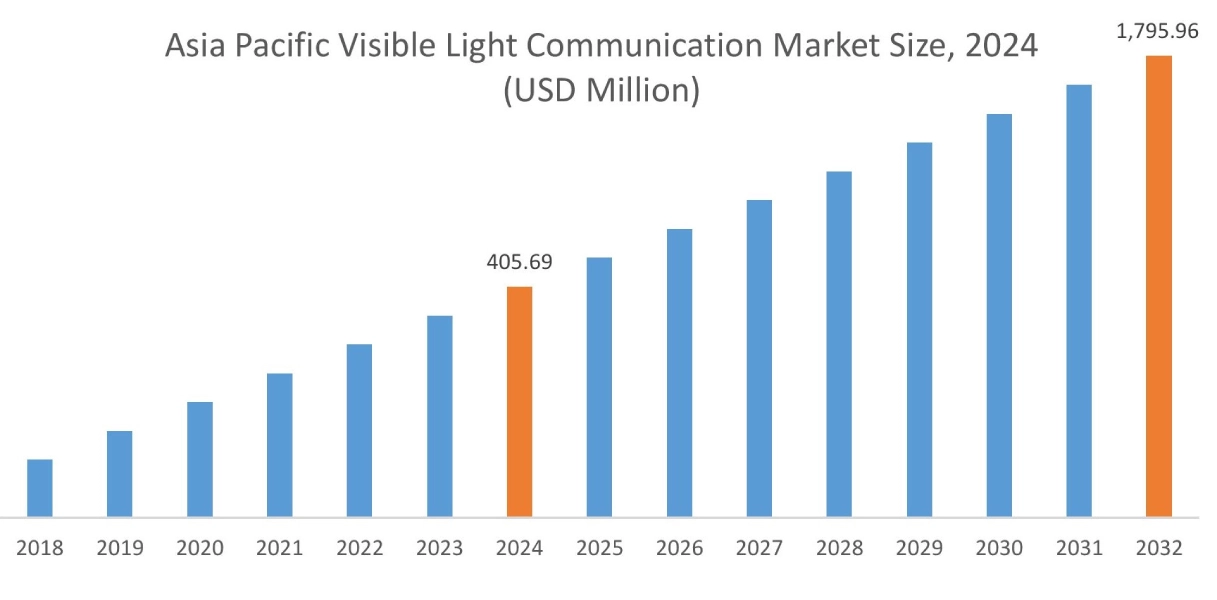
Asia Pacific region was valued at USD 405.69 Million in 2024. Moreover, it is projected to grow by USD 480.93 Million in 2025 and reach over USD 1,795.96 Million by 2032. Out of this, China accounted for the maximum revenue share of 35.90%. The market growth is mainly driven by its deployment in consumer electronics, automotive, and other industries. Furthermore, factors including growing smart city initiatives and rising investment in R&D are projected to drive the market progress in the Asia Pacific region during the forecast period.
- For instance, in September 2023, Getac based out in the chain, partnered with Signify to launch rugged devices embedded with LiFi technology aiming to design, manufacture, and integrate technology to enable customers to utilize the full potential of the technology.
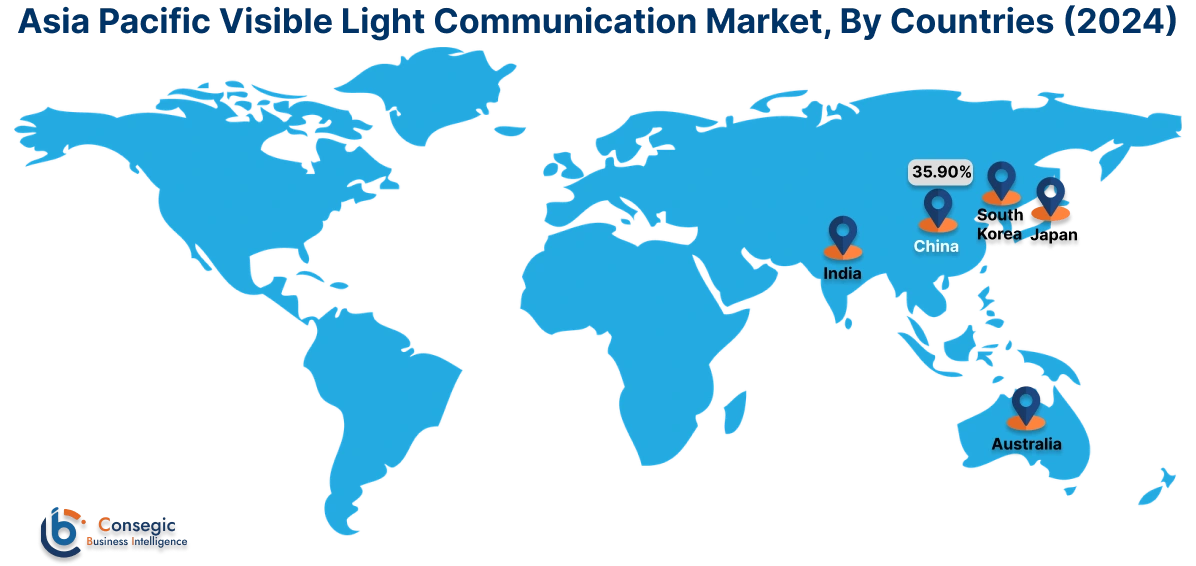
North America is estimated to reach over USD 2,389.20 Million by 2032 from a value of USD 548.16 Million in 2024 and is projected to grow by USD 648.97 Million in 2025. The North American region's growing automotive industry offers lucrative growth prospects for the market. Additionally, the integration with smart lighting systems as well as the rising need for secure and high-speed data transfer in medical devices and patient monitoring is driving the market progress.
- For instance, in October 2020, Light Rider Inc. based out in the USA, launched Light Rider LT and Light Rider Quantum embedded with LiFi and quantum encryption technology for individual users.
The regional analysis depicts that the increase in demand for systems in automotive, healthcare, and smart city initiatives is driving the market in Europe. Additionally, the key factor driving the market is the growing investments in digital transformation, and the rising demand for high-speed, secure wireless communication is propelling the market adoption in the Middle East and African region. Further, the increase in the adoption rate due to the increasing middle-class population and rising awareness of LiFi technology is paving the way for the progress of the market in Latin America region.
Top Key Players and Market Share Insights:
The global visible light communication market is highly competitive with major players providing systems to the national and international markets. Key players are adopting several strategies in research and development (R&D), product innovation, and end user launches to hold a strong position in the visible light communication industry. Key players in the visible light communication market include-
- VLNCOMM (USA)
- Wipro (India)
- Panasonic Corporation (Japan)
- Lucibel (France)
- General Electric Company (USA)
- Signify Holding (Netherlands)
- Segula Technologies (France)
- pureLiFi (UK)
- LiFiComm (India)
- Exar Corporation (USA)
Recent Industry Developments :
Product launches:
- In January 2023, Oledcomm launched LIFIMAX2G designed to enable industries, railways, and other mobility infrastructures to access high-speed transmissions securely, without interference, and avoid resistance.
Partnerships & Collaborations:
- In January 2023, Nav Wireless Technologies Pvt Ltd partnered with the Indian Institute of Technology-Delhi for the development of LiFi technology aiming to deliver high bit rates to mobile users.
Visible Light Communication Market Report Insights :
| Report Attributes | Report Details |
| Study Timeline | 2019-2032 |
| Market Size in 2032 | USD 6,756.79 Million |
| CAGR (2025-2032) | 22.94% |
| By Component |
|
| By Transmission Type |
|
| By Application |
|
| By Region |
|
| Key Players |
|
| North America | U.S. Canada Mexico |
| Europe | U.K. Germany France Spain Italy Russia Benelux Rest of Europe |
| APAC | China South Korea Japan India Australia ASEAN Rest of Asia-Pacific |
| Middle East and Africa | GCC Turkey South Africa Rest of MEA |
| LATAM | Brazil Argentina Chile Rest of LATAM |
| Report Coverage |
|
Key Questions Answered in the Report
How big is the visible light communication market? +
The visible light communication market size is estimated to reach over USD 6,756.79 Million by 2032 from a value of USD 1,573.04 Million in 2024 and is projected to grow by USD 1,860.03 Million in 2025, growing at a CAGR of 22.94% from 2025 to 2032.
Which segmentation details are covered in the visible light communication report? +
The visible light communication report includes specific segmentation details for component, transmission type, application, and regions.
Which is the fastest segment anticipated to impact the market growth?q +
In the visible light communication market, the automotive sector is the fastest-growing segment during the forecast period due to the rising adoption of emerging technology that offers potential for both vehicle-to-vehicle (V2V) and infrastructure-to-vehicle (I2V) communication.
Who are the major players in the visible light communication market? +
The key participants in the visible light communication market are VLNCOMM (USA), Signify Holding (Netherlands), Segula Technologies (France), pureLiFi (UK), LiFiComm (India), Exar Corporation (USA), Wipro (India), Panasonic Corporation (Japan), Lucibel (France), General Electric Company (USA) and others.
What are the key trends in the visible light communication market? +
The visible light communication market is being shaped by several key trends including a growing focus on data security and real-time patient monitoring as well as integration with IoMT devices and others are the key trends driving the market.
